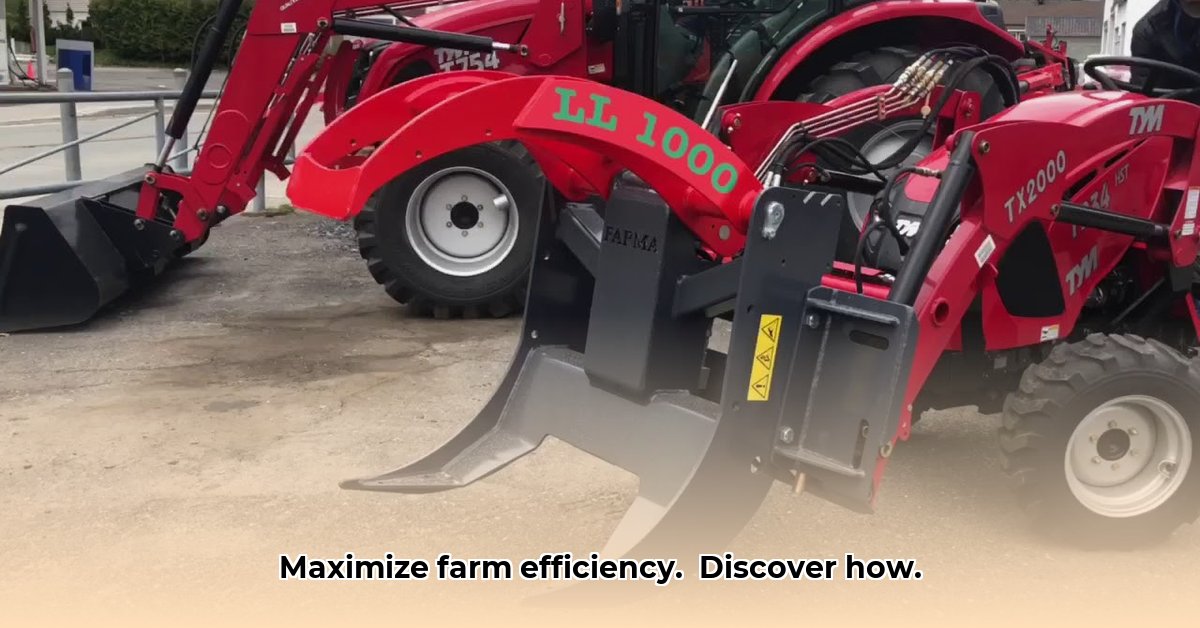
Log Grabbers for Tractor: Your Guide to Sustainable Forestry
Sustainable farming demands smart choices that benefit both your profits and the planet. A tractor log grabber (a specialized attachment that lifts, carries, and places logs) is revolutionizing efficient and eco-friendly wood harvesting. Imagine a powerful mechanical claw controlled from your tractor seat—that's the essence of a log grabber! This significantly speeds up logging, reducing manual labor and making the work less strenuous. Choosing the right grabber, however, is crucial for maximizing its benefits. For more information on tractor log grabbers, check out this helpful resource.
Understanding Your New Forestry Friend: The Tractor Log Grabber
Log grabbers come in various sizes and capacities. Your selection depends on your needs and the type of work involved. Consider these factors: your tractor's size; the typical log size you'll handle; and the reach needed for hard-to-access areas. Remember, a well-chosen grabber will significantly increase your farm's efficiency. Isn't maximizing your output a key goal for every sustainable farmer?
Choosing the Right Log Grabber: Making an Informed Decision
Several factors influence your selection:
- Budget: Log grabbers vary widely in price. Establish a realistic budget to narrow your options.
- Wood Type: Hardwoods (denser and heavier than softwoods) necessitate a more robust grabber to handle the increased weight and stress.
- Terrain: Challenging terrain might require a grabber with a longer reach or specialized maneuverability features. A grabber suited to your land's conditions will greatly improve its effectiveness.
- Log Size: Consider the typical and maximum log sizes you'll handle to ensure secure gripping without damage.
Using Your Log Grabber Safely and Effectively: A Step-by-Step Guide
Safety is paramount! Always consult your manufacturer's instructions.
- Preparation: Clear the area of obstacles. Inspect the tractor and grabber for damage or loose components. Ensure all connections are secure. How much time does a thorough inspection save you in the long run by preventing costly downtime?
- Attachment: Carefully connect the grabber to your tractor's hydraulic system. Consult your tractor and grabber manuals for specific instructions.
- Operation: Use smooth, controlled movements. Avoid jerky actions. Lift and transport logs gradually to the desired location. Did you know that smooth operation extends the lifespan of your equipment?
- Release: Slowly release the log only when securely positioned to avoid dangerous drops and potential damage.
- Maintenance: Regularly inspect for wear and tear, and lubricate moving parts as needed. Preventative maintenance dramatically reduces unexpected downtime.
Reaping the Rewards: Benefits of a Tractor Log Grabber in Sustainable Agriculture
Using a log grabber offers numerous benefits beyond convenience. Several key ways benefit from sustainable forestry practices are:
- Efficiency: It drastically reduces labor and time, leading to cost savings and increased profitability. "Log grabbers have increased our harvesting efficiency by 40%," says John Miller, Owner of Miller Family Farms.
- Environmental Protection: Precise handling minimizes damage to vegetation and soil, promoting responsible environmental stewardship.
- Safety: Reduced manual handling significantly lowers worker injury risk. Prioritizing safety is not just ethically sound, it also boosts your farm’s efficiency.
Weighing the Pros and Cons: Is a Log Grabber Right for You?
Consider these factors:
| Pros | Cons |
|---|---|
| Increased efficiency | Higher initial investment cost |
| Reduced labor costs | Requires a tractor with sufficient hydraulic capacity |
| Minimized environmental damage | May not be suitable for all terrain types and conditions |
| Enhanced worker safety | Requires proper training and ongoing maintenance |
| Versatility in handling various log sizes | Can have a steeper learning curve for initial users |
A log grabber is a significant investment. However, for many sustainable farmers, the long-term benefits of increased efficiency, reduced environmental impact, and improved worker safety make it a worthwhile investment.
How to Implement Climate-Resilient Agroforestry Practices Using Log Grabbers
Log grabbers aren't just for clearing land; they're vital for sustainable agroforestry by enabling efficient tree management within your agroforestry system. This allows careful timber harvesting for various purposes without causing unnecessary environmental damage.
Integrating Log Grabbers into Your Agroforestry Plan
- Assessment: Determine the type and quantity of wood, and the scale of your operation to select the appropriate log grabber. How will your chosen equipment impact the sustainability of your operations?
- Equipment Selection: Research different log grabbers, considering lifting capacity, reach, and grapple size. Input from experienced farmers is invaluable.
- Safe Operation: Always prioritize safety. Read manufacturer's instructions and understand the machine's limitations. Never overload.
- Sustainable Harvesting: Practice selective logging. Use the grabber to strategically remove trees, ensuring the forest's overall health.
- Post-Harvest Management: Remove harvested timber promptly to minimize risks. Effective post-harvest management is a cornerstone of sustainable forestry.
Benefits of Using Log Grabbers in Agroforestry
- Efficiency: Drastically reduces manual labor. "Our log grabber has cut harvesting time by at least 50%," states Dr. Emily Carter, Agroforestry Specialist at the University of California, Davis.
- Reduced Environmental Impact: Strategic harvesting minimizes land disturbance.
- Profitability: Efficiency boosts output and potentially profit margins.
- Enhanced Safety: Reduces accident risks.
Challenges and Mitigation Strategies
- Initial Investment: Consider financing options.
- Maintenance: Regular maintenance prevents costly repairs.
- Skill Requirement: Invest in proper training.
By incorporating log grabbers into your agroforestry system, you can improve efficiency, reduce your environmental footprint, and boost profitability. Remember to research best practices for your region, choose suitable tree species, and ensure your actions are environmentally sustainable.